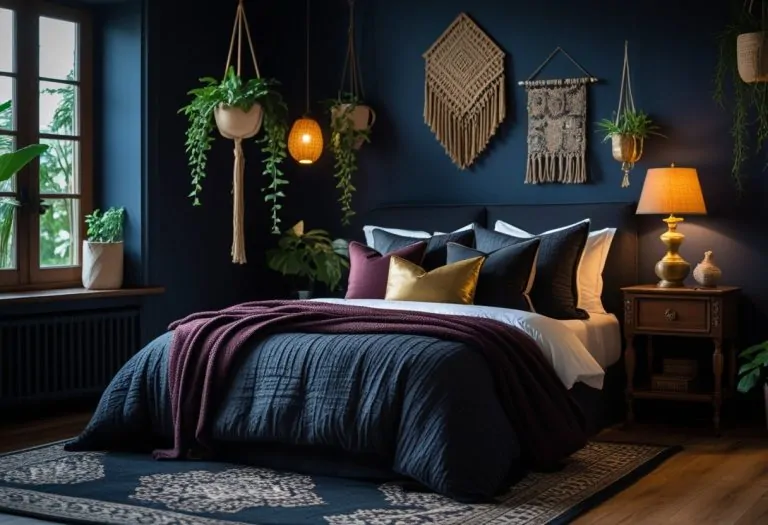Budget Outdoor Kitchen Ideas for a Stylish Backyard
Creating a stylish and functional outdoor kitchen doesn’t have to drain the wallet. With smart planning and creative choices, anyone can transform their backyard into a vibrant cooking space without overspending. These 15+ stunning outdoor kitchen ideas prove that it’s possible to enjoy a beautiful, practical outdoor cooking area on a budget.

From sleek modern setups to rustic charm, the ideas cover a broad range of styles and layouts, helping homeowners find inspiration that fits their taste and space. Incorporating cost-effective materials and thoughtful appliance selections can elevate an ordinary backyard into a welcoming culinary oasis.
The post also offers practical tips on how to maximize functionality while keeping costs down. It shows how to add eye-catching accents on pictures to make design ideas stand out and help readers envision their ideal outdoor kitchen.
Budget-Friendly Outdoor Kitchen Ideas
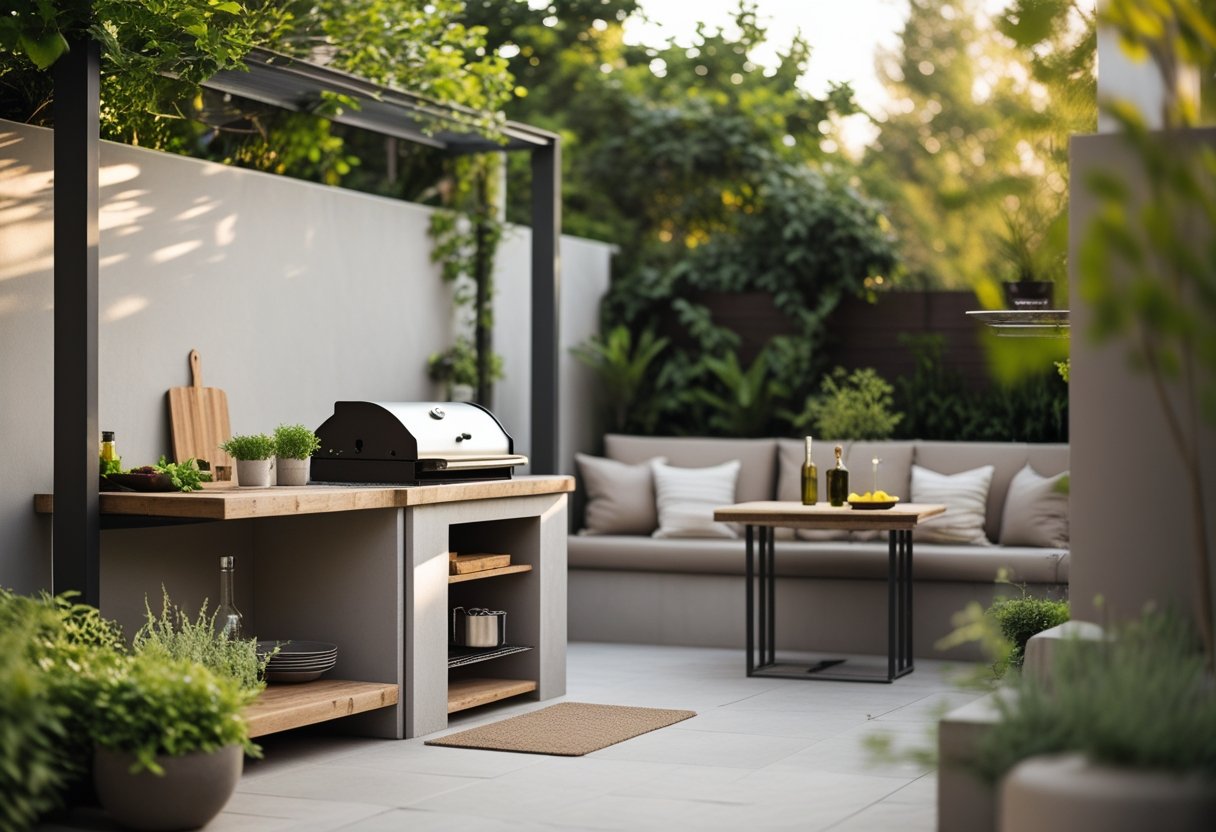
Creating an outdoor kitchen that fits both style and budget involves smart choices in materials, appliances, and layout. Simple adjustments and thoughtful planning can produce a modern outdoor kitchen design without overspending. Practical DIY projects, repurposed materials, cost-effective appliances, and efficient layouts are essential strategies for affordability.
DIY Projects to Save Money
Building components yourself significantly cuts costs. Tasks like constructing countertops from concrete or pallets, assembling simple cabinetry, or creating a basic pergola offer affordable ways to add functionality.
DIY projects also allow customization to exact space needs. Even beginners can tackle tasks such as installing built-in grills or making outdoor seating with step-by-step guides available online.
By investing time instead of money, homeowners can achieve stylish outdoor cooking areas that meet personal preferences without paying for professional labor.
Repurposed Materials and Upcycling
Using repurposed materials reduces expenses and adds unique character. Salvaged bricks, reclaimed wood, or leftover tiles can form durable surfaces or accent features.
Upcycling old furniture or pallets into kitchen islands, storage units, or herb planters saves money and fits well with rustic or modern outdoor kitchen ideas.
Repurposed materials often require some cleaning or refinishing but reward with eco-friendly, distinctive elements that boost the overall design without increasing cost.
Affordable Appliance Options
Choosing appliances wisely balances quality and price. Compact grills, portable cooktops, or single-burner setups work well in small spaces and cost less than full outdoor kitchens.
Look for efficient, outdoor-rated appliances with good warranties rather than high-end brands. Solar-powered or propane models decrease utility expenses.
Built-in storage with integrated coolers or drawers can be added gradually, spreading costs. Prioritize must-have appliances first, then add extras over time.
Cost-Effective Layouts
Maximizing space use with a practical layout cuts unnecessary expenses. Positioning cooking, prep, and seating areas close together reduces the need for extensive plumbing or electrical work.
L-shaped or linear designs fit narrow yards while keeping everything accessible. Mobile or modular kitchens allow flexibility for small patios or future expansion.
Simple layouts often use pre-made islands or countertops combined with open shelving instead of custom cabinets to maintain an airy feel on a budget.
Space-Saving Designs for Small Backyards
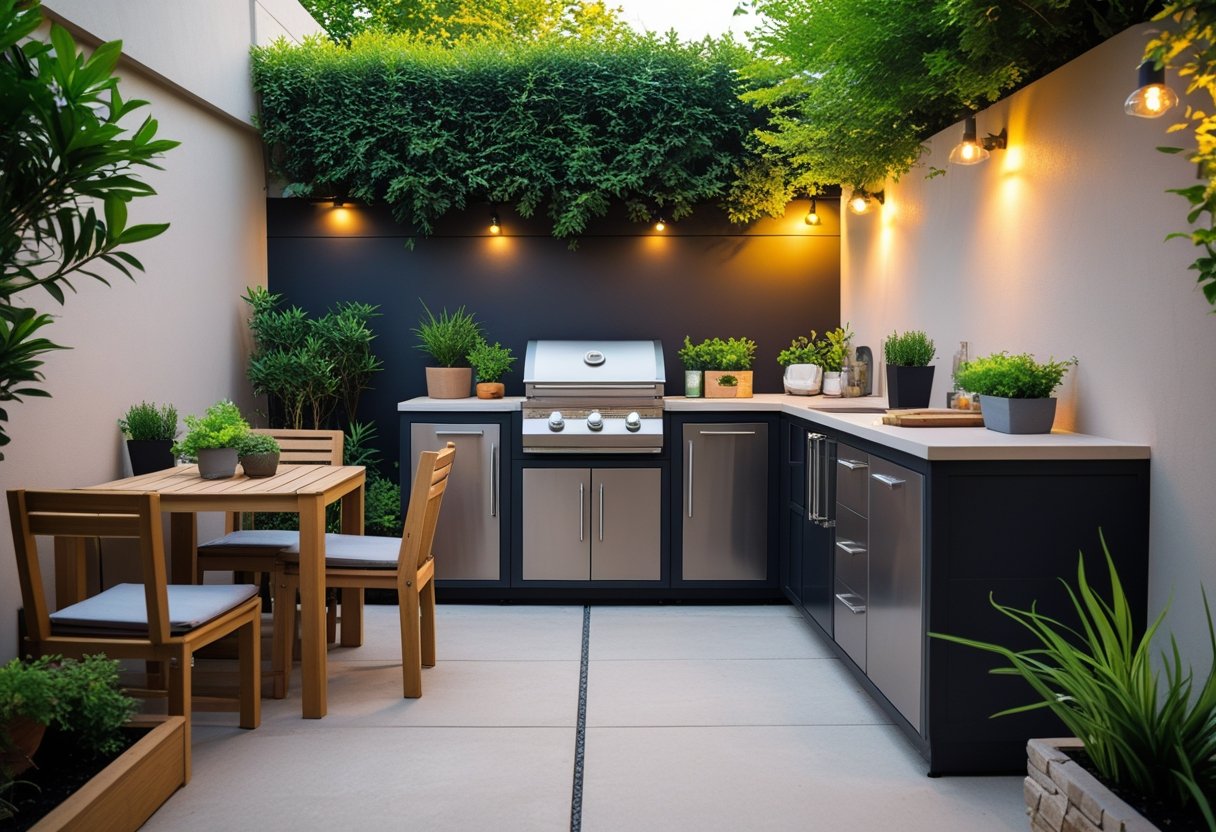
Maximizing limited space involves smart kitchen layouts, efficient use of corners, and versatile islands. These setups focus on maintaining functionality while creating inviting spots for cooking and socializing. Seating, storage, and flow are all considered to get the most from a small backyard kitchen.
Compact Island Kitchens
Compact island kitchens serve as multifunctional hubs. Typically, islands include a cooking surface, prep area, and often integrated storage underneath. Incorporating bar stools along one side adds casual seating without taking up extra room.
They can fit well in the center of a small backyard or just outside sliding glass doors, bridging indoor and outdoor spaces. Islands with wheels or modular designs offer flexibility, allowing relocation when more open space is needed for gatherings.
Choosing islands with built-in appliances, like a grill or mini fridge, consolidates necessities. Materials resistant to weather ensure durability, while a minimalist design keeps the area feeling open.
L-Shaped Layouts for Corners
L-shaped layouts use corner spaces efficiently, wrapping the kitchen along two adjoining walls. This approach fits tight backyard corners and leaves room for a dining area or moving around comfortably.
The design supports installing countertop space next to seating or bar stools, making it easy to serve food directly to guests. Adding under-counter storage optimizes space while keeping essentials accessible.
It works well for outdoor kitchens installed near sliding glass doors, creating a seamless indoor-outdoor transition. Compact appliances and vertical storage, such as mounted shelves or hooks, enhance organization without crowding the area.
U-Shaped Setups for Efficiency
U-shaped outdoor kitchens maximize counter and storage space by surrounding the cook on three sides. This setup suits backyards with slightly wider spaces but is still ideal for small yards when designed carefully.
It allows distinct zones for grilling, prepping, and washing. The layout supports multiple users, making it functional for social cooking or family gatherings.
Incorporating weather-resistant cabinetry and integrated appliances like compact grills or small refrigerators keeps the kitchen neat. Adding bar stools on the open side encourages interaction without narrowing walkways.
This design fits well just outside sliding glass doors, creating an extended living area with easy access to indoor amenities.
Covered Outdoor Kitchen Inspiration

Choosing the right cover for an outdoor kitchen enhances usability while protecting cooking equipment and diners. Key options range from permanent structures to flexible shades, each offering different levels of shelter and style. Proper weatherproofing is also essential to maintain durability and comfort.
Pergolas and Retractable Awnings
Pergolas combine open, airy structures with partial shade, making them a favorite for covered outdoor kitchens. They typically use sturdy wooden or metal beams and can be enhanced with climbing plants or fabric inserts to boost coverage.
Retractable awnings offer versatility by extending coverage only when needed, keeping the space open and sunny otherwise. Made of waterproof fabric, these awnings can be motorized for easy control. They work well in small and large areas, providing protection from sun and light rain without permanent installation.
Both options allow airflow, minimizing heat buildup while offering protection from direct sunlight, which is critical for comfort and appliance longevity.
Gazebo and Pavilion Structures
Gazebos and pavilions provide fully covered, often enclosed or semi-enclosed outdoor kitchen spaces. These structures are built from wood, metal, or composite materials and usually feature solid roofs.
They protect from all weather conditions, including wind and heavy rain, making year-round use more practical. A pavilion might include side panels or screens that block bugs and wind but can be opened for ventilation.
With a more formal presence, these structures often serve as outdoor dining rooms and social hubs. Their design typically integrates lighting and power access, ideal for comprehensive kitchen setups.
Shade Sails and Canopies
Shade sails and canopies create flexible, stylish coverage with minimal construction. Shade sails use tensioned fabric triangular or rectangular shapes anchored to posts or nearby buildings.
They offer sun protection and come in various UV-resistant fabrics and colors. Canopies resemble large umbrellas or tents and can be freestanding or attached to a deck or patio.
These solutions suit modest budgets and smaller spaces. While not fully waterproof, many fabrics repel light rain, providing adequate shelter for casual outdoor cooking and dining.
Weatherproofing Essentials
Effective weatherproofing focuses on materials and design details that extend the life of an outdoor kitchen. Use corrosion-resistant metals like stainless steel or powder-coated aluminum for appliances and fixtures.
Ensure countertops and cabinets are made from weatherproof materials such as granite, concrete, or marine-grade polymer. Installing drainage solutions and sealed flooring helps prevent water damage.
Incorporating outdoor lighting rated for moisture exposure and installing retractable or removable covers on appliances also preserves functionality and safety. Weatherproofing balances durability with maintenance needs in any covered outdoor kitchen design.
Stylish Surfaces and Countertops

Choosing the right surface material is crucial for an outdoor kitchen. Durability, maintenance, and appearance all matter. Materials such as stone, granite, concrete, and wood provide a range of styles that fit different budgets and design preferences.
Stone Countertop Options
Stone countertops offer natural beauty and resilience, making them popular for outdoor kitchens. Options like slate, quartzite, and soapstone provide excellent resistance to heat and weather.
Soapstone is smooth and non-porous, requiring minimal sealing. Quartzite offers a polished look similar to marble but with better durability outdoors. Slate provides a rustic, textured surface resistant to chips and cracks.
Maintenance varies: regular resealing may be needed except with soapstone. Stone countertops bring an elegant yet sturdy feel that holds up well in changing outdoor conditions.
Granite and Concrete Finishes
Granite countertops are prized for their toughness and visual appeal. They resist heat, scratches, and stains, ideal for heavy outdoor use. Each granite slab has unique patterns, adding distinct character.
Concrete countertops allow for customization in color and texture. They can mimic stone or showcase sleek, modern finishes. Concrete is durable but requires sealing to prevent staining and water absorption.
Both granite and concrete are weather-resistant, but granite generally demands less upkeep. Concrete’s versatility lets homeowners tailor countertops to their style while maintaining strength.
Wooden Accents & Cabinets
Wooden cabinets and accents introduce warmth and natural detail. Hardwood species like teak, cedar, or redwood withstand moisture and insect damage better than softer woods.
Wood cabinets should be sealed with outdoor-grade finishes to protect them from weathering. Their appearance ages gracefully, developing a patina over time, which some homeowners find appealing.
Combining wooden cabinets with stone or concrete countertops balances rugged durability with organic warmth. Proper maintenance ensures wood lasts while enhancing the overall outdoor kitchen design.
Outdoor Kitchen Features for Entertaining
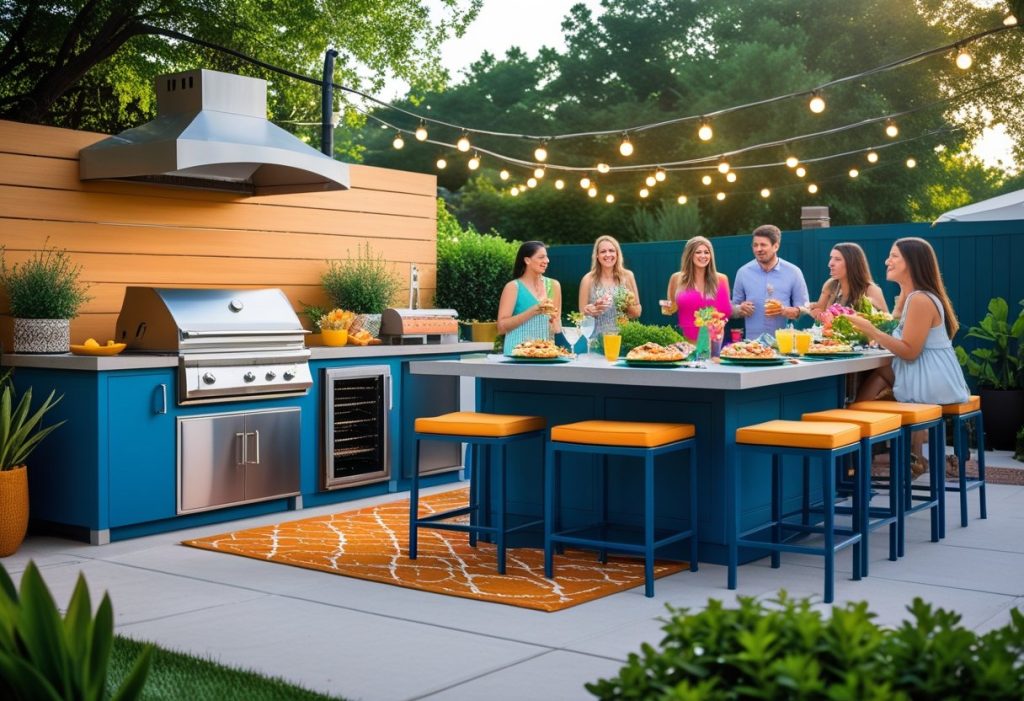
Creating an outdoor kitchen that enhances social gatherings depends on combining comfortable seating, effective lighting, and practical appliances. Attention to these elements ensures the space is functional, inviting, and easy to use during events.
Bar Area and Seating
A well-designed bar area encourages interaction and keeps guests comfortable. Incorporating sturdy bar stools with weather-resistant materials ensures seating that lasts through seasons. The bar countertop should be spacious enough to hold drinks, snacks, and serving dishes.
Positioning the bar strategically allows hosts to face guests while preparing food or drinks. Adding storage beneath the bar keeps utensils and glassware within reach, improving efficiency. Durable materials like stone or treated wood balance aesthetics with practicality for outdoor use.
Lighting and Ambiance Enhancements
Proper lighting extends usability into the evening and sets the atmosphere. String lights provide a warm, cozy glow ideal for casual gatherings. Installing recessed lighting in overhead structures creates focused illumination without harsh glare.
Combining ambient and task lighting allows guests to move safely while highlighting food prep areas. Solar-powered or LED options reduce energy use and maintenance. Layering lights at different heights adds visual interest and defines specific zones in the outdoor kitchen.
Appliance Integration
Appliance choices impact convenience and durability in outdoor kitchens. Stainless steel appliances resist rust and withstand weather exposure better than other materials. Essential components include grills, refrigerators, and side burners, chosen to match available space and cooking needs.
Integrated appliances create a seamless look and streamline cooking processes. Positioning items for easy access maintains workflow during entertaining. Opting for appliances with temperature controls and energy-efficient ratings improves both performance and resource use.
Functional and Modern Upgrades

Adding practical and stylish features can enhance both the usability and aesthetic appeal of an outdoor kitchen. Smart upgrades focus on convenience, space-saving design, and integrating natural elements to create an inviting cooking environment.
Built-In Grills and Fire Pits
A built-in grill is central to many outdoor kitchens, offering durability and a sleek, permanent cooking station. Choosing stainless steel models provides corrosion resistance and easy maintenance, important for long-term use. Positioning the grill within a stone or tile counter adds to the overall structure’s solidity and appearance.
Fire pits complement built-in grills by extending cooking and social areas into cooler evenings. They can be gas- or wood-fueled, depending on preference and local regulations. Installing a fire pit near seating makes the space more versatile, allowing for warmth and ambience without crowding the cooking zone.
Herb Gardens and Green Elements
Incorporating a small herb garden near the cooking area adds freshness and practicality. Raised planters or vertical garden walls maximize limited space while keeping herbs within easy reach. Common choices include basil, rosemary, and thyme, which thrive in outdoor conditions and enhance cooking flavors.
Adding greenery also softens hard surfaces and creates a more inviting atmosphere. Plants with aromatic qualities not only look good but reduce insects and improve air quality around the kitchen area. Using drought-resistant or low-maintenance plants minimizes upkeep.
Climate Control: Ceiling Fans & Ventilation
Ceiling fans are effective for maintaining comfort by circulating air, reducing heat buildup, and deterring insects. They should be rated for outdoor use to withstand moisture and weather exposure. Strategically placing fans over seating and cooking zones ensures consistent airflow.
Proper ventilation is essential when using built-in grills to prevent smoke accumulation. Incorporating vent hoods or designing open layouts allows smoke to escape quickly. Combining ventilation strategies with fans enhances safety and keeps the space comfortable during use.
Specialty Settings and Themed Designs
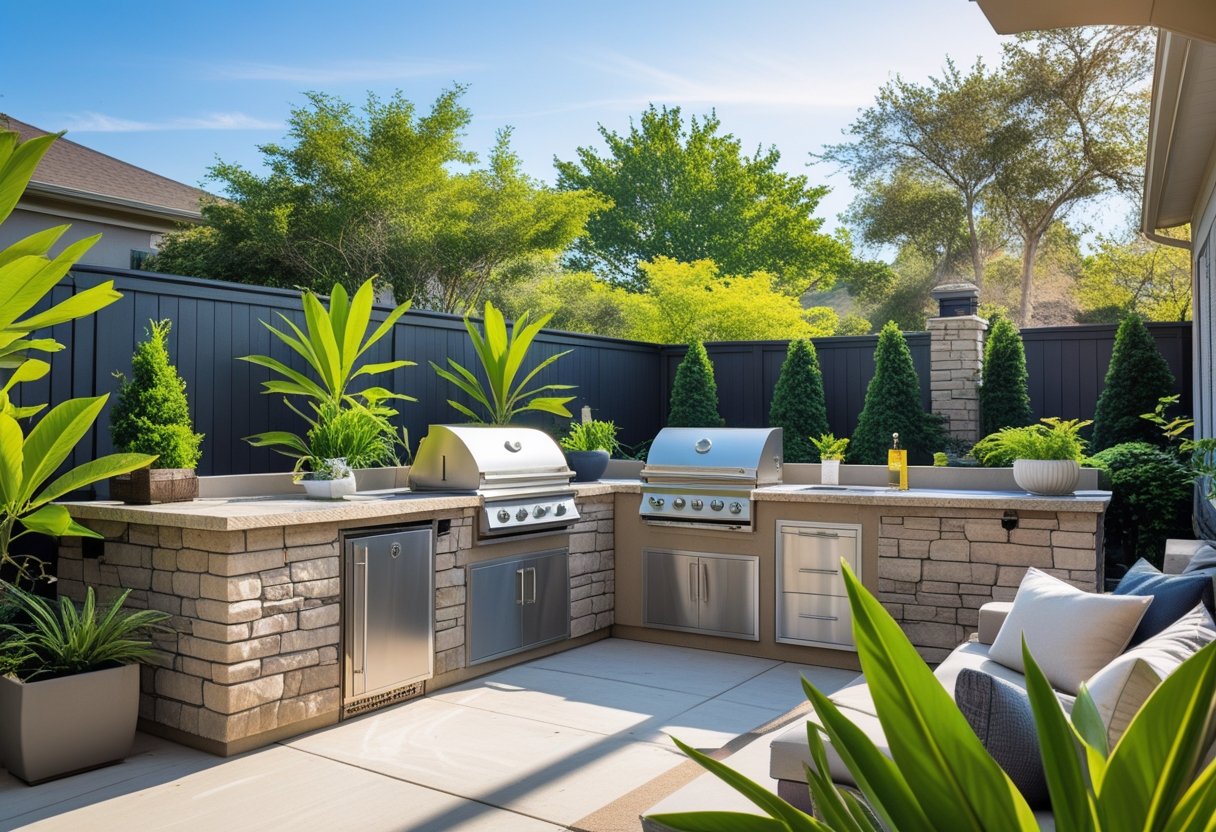
Outdoor kitchens can be tailored to specific environments and aesthetic themes, enhancing both their functionality and visual appeal. Integrating location-focused elements and cultural styles helps create distinctive spaces that fit the user’s lifestyle and outdoor layout.
Poolside Outdoor Kitchens
A poolside outdoor kitchen focuses on convenience and durability against moisture and sun exposure. Materials such as stainless steel and weather-resistant cabinetry are essential to withstand humidity and pool chemicals.
Counter space near the poolside is important for food prep and serving drinks. Including built-in grills, mini-fridges, and bar seating enhances the social atmosphere.
Non-slip flooring, such as textured concrete or stone tiles, improves safety around wet areas. Placement is key: the kitchen should be close enough to the pool for easy access but positioned to avoid splashes or water damage.
Mediterranean and Rustic Styles
Mediterranean designs feature terracotta tiles, warm colors, and wrought iron fixtures, creating an inviting and timeless outdoor kitchen. Terracotta tiles provide both style and durability, suited for outdoor conditions and complementing natural surroundings.
Rustic styles emphasize raw materials like wood, stone, and brick. These kitchens often include open shelving and farmhouse sinks. A fire pit or wood-burning oven can add authenticity and warmth.
Both styles benefit from textured surfaces and natural tones that blend seamlessly with gardens or patios. Attention to artisanal details distinguishes these kitchens from more modern, minimalist designs.
Alfresco Dining Experiences
Alfresco dining areas prioritize comfort and ambiance alongside food preparation space. Integrating bar seating or dining tables next to the kitchen encourages social interaction and ease of serving.
Shade solutions, such as pergolas or retractable awnings, protect guests from weather while enhancing style. Weather-resistant furniture and cabinetry maintain functionality throughout changing seasons.
Lighting also plays a crucial role. Soft, warm lighting options create a welcoming atmosphere for evening meals. This setting transforms the outdoor kitchen into a true extension of the home’s living space.


